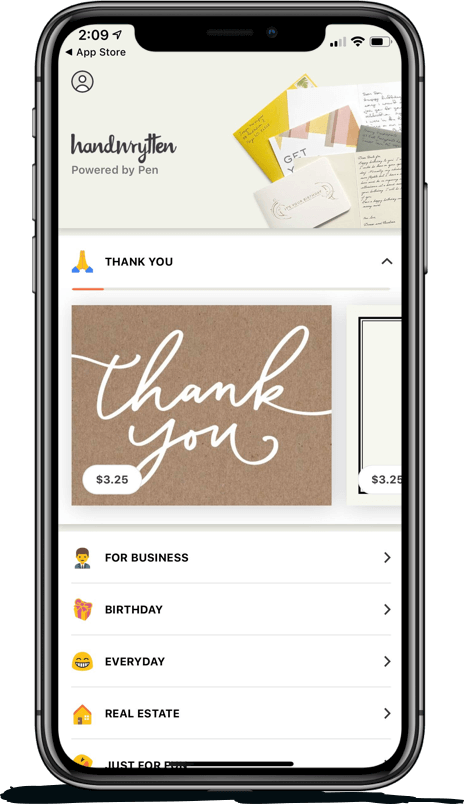
9280 S. Kyrene Rd.
Suite 134
Tempe, AZ 85284
Phone: +1 (888) 284-5197
Email: contact@handwrytten.com



You have been subscribed. Thank you!


No matter what business you’re in, you want to build authentic, meaningful relationships with your customers. If you’re wondering how to build rapport with customers, some simple guidelines will help. You want to leave your customer feeling good, even if they’re coming to you with a complaint. These examples of building rapport with customers will help you to start having positive interactions with customers so that they keep turning to you for your product or service.
You want to connect with your customers, and addressing them correctly is the first step. Using the customer’s names and preferred pronouns will show that you respect them. Mutual respect and understanding is the first step to building rapport between your customer and your business.
When it comes to names, you want to take the time to correctly pronounce (if you’re speaking) or spell (if you’re communicating in writing) the person’s name. If you’re not sure how to pronounce a name when you’re calling a customer, see if someone you work with has spoken with them before. Try to have the customer introduce themselves if you’re still unsure.
You can always say you didn’t catch the name and ask them to repeat it if you’re feeling uncertain — most customers will appreciate this effort. Pronouncing or spelling someone’s name right will start off your interaction in a positive way.
Likewise, you should be mindful of pronouns if you’re using them to address a customer. A customer may state their pronouns to you, and then you should follow what they use. If a customer doesn’t say anything, avoid using pronouns, and use their name when possible. You won’t often have to use pronouns if you’re speaking directly to a person, but this is an important added measure to show respect for a person and how they identify.
With both names and pronouns, letting the customer take the lead will point you in the right direction. If you’re reaching out to an Elizabeth Smith and they call themselves Elizabeth, refer to them in as Elizabeth in response. If they call themselves Ms. Smith, follow along. You don’t want to jump right into calling this person Lizzie — unless they do it first!
Building rapport with customers isn’t just about saying their name right, of course. You want to show the customer you care throughout any interaction. If you’re communicating with a customer who is facing a problem, no matter if you’re reaching out to them proactively or reactively, you want to prepare yourself to communicate empathetically.
Avoid getting defensive or acting like the concern is irrelevant or unimportant. Even if you’ve dealt with the issue a million times and it really is an easy fix, your customer wants to feel like they’re important to you. Treat every interaction like it’s new and unrelated to anything you’ve done in the past. Showing that you’re empathetic to a customer’s problems will help steer the conversation in a positive direction.
After a call or meeting, you can follow up with a handwritten note or personal video email. Show you care and follow the issue through to resolution.
Maybe you have a pre-written script for phone calls or emails. That’s fine! Many customer representatives do. Scripts can be useful when you blank on what to say, or if you’re unsure of appropriate wording.
When you’re responding to a customer, though, scripts make you sound either robotic or worse, apathetic. Put that script aside, listen, and hear what the customer is really saying to you. Wait until their done speaking or you’ve read their whole message. Then, respond in your own words. Craft a reply as if you were speaking with a friend who comes to you explaining a problem. Losing the script goes a long way when you want to build rapport by making conversations authentic and welcoming.
A customer who has just burst into an exasperated and long-winded run-down of their problem doesn’t want an immediate defensive response. Saying, “I get it, but…” implies that you actually don’t get it.
Once you’ve actively listened to what a customer has to say, try instead to restate the problem using your own words. You can try something like, “I’m hearing that your main issue is that __, and that’s causing __. Is that right?”
Your customer can then either correct you, which will make the situation easier for you to understand. Or, they’ll confirm that you got it right so you can jump right into helping them. Either way, you’re building rapport by demonstrating that you’re taking an active role in trying to understand them and help them.
Customers usually contact you driven by one of two emotional responses. They’re either trying to get away from discomfort and pain, or they’re moving towards a positive response. Typically, one or the other will be the dominant force in a conversation.
You build a rapport with your customer when you react in line with their emotions. If they’re coming for help to move away from discomfort, they may seem agitated or worried in their communication. Recognize this, and use empathy when you’re responding. If they sound more upbeat, on the other hand, you should stay enthusiastic in your responses.
Mirroring the customer will help you respond in an appropriate manner. Imagine you come to someone already feeling frustrated, and their response is to crack jokes and encourage you to see the best in the moment. That’s likely going to make a bad day feel worse! If a customer is in a good mood, you can echo that. If they seem angry or upset, an understanding and sympathetic, though still friendly, response will be more effective.
When you recognize what’s driving the customer’s communication and tailor your style of response to fit this, you’ll boost your emotional connection with the customer. This, in turn, builds rapport.
Learning how to respond authentically and respectfully to customer communications will help you build rapport with your customers. Addressing a customer the way they want to be addressed, listening well, and understanding their emotions will create positive relationships.


Scale your handwritten outreach, creating positive impressions and long lasting bond.
Sign Up Today!


Over 100 designs to choose from or design your own. Our online card customizer makes it simple.
Check Out Our Cards!





